
Snowmageddon
What….Was…That?!?!!? Ok sure, we can handle some “quaint” snow on say…Dec 24th/25th or even the exact moment we fall in love but beyond that, us Islanders have a pretty low snow tolerance…which is why this past week was snow good. 😉 Yes the snow started off kinda pretty and, ok, even I found myself ooooing and awing, but multiple traffic accidents, school cancellations, tree deaths and ruined hairstyles later, it was just too much. Like many of you, I spent the week clearing driveways, walkways and entire parking lots by hand which is why I got a kick out of the above picture. As I write this, I’m sitting in my cozy coffee shop and it looks like we’ve finally beaten this thing which is why I can finally reflect on the week that was Snowmageddon. But what’s all of this mean for your lawn? Well…it’s not great.
First off, it’s important to realize that all grass on Vancouver Island is cool season grass so from a temperature point of view, your lawns can handle the snow. (This is why your lawn stays green in the winter and turns brown in the summer.) The larger concern is the amount of snow we received at once and the implications of how fast it will inevitably melt. Here’s the fall out you need to be prepared for…(every lawn is unique and some are healthier then others so you may not experience all of these things but if you do, at least now you’ll be prepared!)
1. Soil Compaction: Most of you have several feet of snow currently piled on your lawn. As you know from shovelling, the snow is not light. The weight is compacting your soil and will result in trapped nutrients/air/water. When your lawn wakes up this spring, it may not be able to access what it needs to grow and it will show its dissatisfaction with a thin, pale complexion. Weeds will appear and quickly take advantage of this vulnerable situation. A spring aeration and natural fertilizer application will be essential in releasing and activating these trapped nutrients.
2. Water Logging: As I write this, the snow is melting as quickly as it came resulting in massive amounts of water washing over and through your lawn (taking nutrients and organic matter with it). If your lawn didn’t already have poor drainage, it does now. It can’t possibly hold all that water. Be prepared for your lawn to be very slimy or even disappear in places. Depending on the quality of your soil and the health of your lawn, it may eventually recover as it dries out later in the spring but more likely than not you are going to need topdressing and reseeding this spring along with the aeration. If your lawn takes unreasonably long to drain this is a cue that you have an underlying drainage problem that must be fixed before you even attempt to get your lawn lush again. I realize this is starting to sound like a sales pitch and that is not my intent. I’m just wanting you to be prepared and have a plan. I’ll definitely be doing the same to my own lawns.
3. Salt Damage: Many Municipalities (and homeowners) still salt their roadways, walkways and driveways even though there are great lawn friendly alternatives, including sand and eco-traction. The problem with salt is it inevitably ends up all over your lawn and garden burning everything in sight, similar to over-fertilizing. Those brown/dead patches will be the tell tale sign that you didn’t go easy on the salt this winter. Depending on the damage, you may have to power-rake out the dead sections as well as aerate, top-dress and seed. In other words, you may need a mini lawn renovation. If you are one of the lucky ones already signed up for one of our popular Lawn Care Programs, you will be receiving all of these things as part of your program! Lucky you 🙂
4. Fungal disease (snow mold): Watch out for a weird abnormal colour appearing on your lawn next month. Pink and grey are the most common colours indicating your lawn has a fungal infection. The disease is seldom fatal although always un-nerving to the unprepared. The solution is the same as above…raking out the affected sections and topdressing/reseeding.
Beyond these four things, many of you may also be dealing with broken trees, damaged shrubs and a huge amount of debris on your lawn as a result of the snow storm. Best to remove the debris asap as well as call in an expert to take a look at your plants.
While we can’t always predict the weather, we can reasonably predict the result of it on our lawns. With greater knowledge, we can be more prepared and less anxious this season. See you on the lawns!
